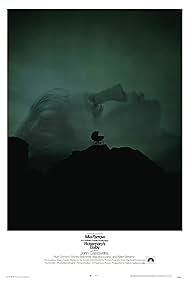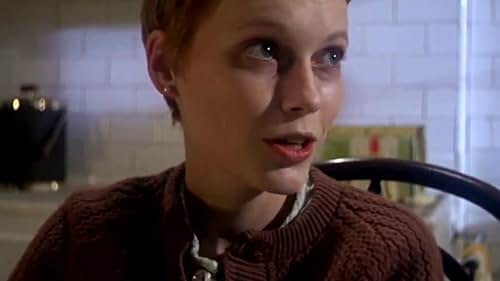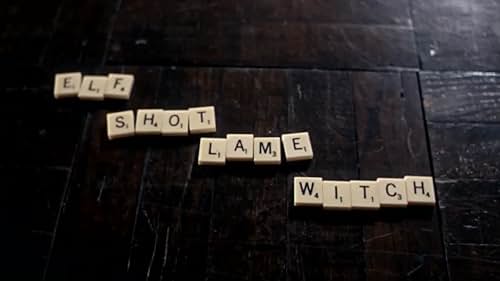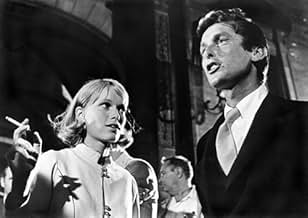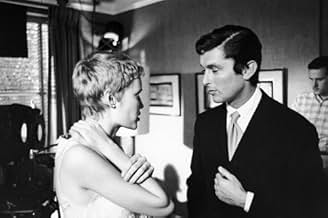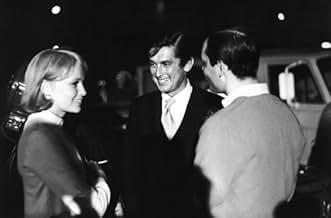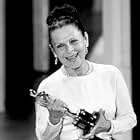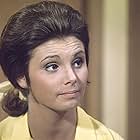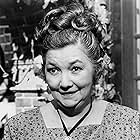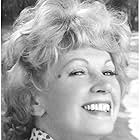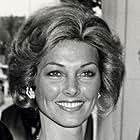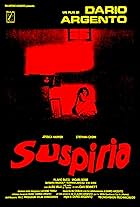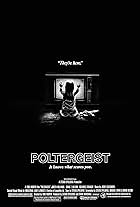Una giovane coppia si trasferisce in un appartamento e si ritrova circondata da strani vicini e avvenimenti. Quando la moglie rimane misteriosamente incinta, viene assalita dalla paranoia su... Leggi tuttoUna giovane coppia si trasferisce in un appartamento e si ritrova circondata da strani vicini e avvenimenti. Quando la moglie rimane misteriosamente incinta, viene assalita dalla paranoia sulla sicurezza del bambino che dovrà dare alla luce.Una giovane coppia si trasferisce in un appartamento e si ritrova circondata da strani vicini e avvenimenti. Quando la moglie rimane misteriosamente incinta, viene assalita dalla paranoia sulla sicurezza del bambino che dovrà dare alla luce.
- Vincitore di 1 Oscar
- 13 vittorie e 13 candidature totali
Victoria Vetri
- Terry
- (as Angela Dorian)
Elisha Cook Jr.
- Mr. Nicklas
- (as Elisha Cook)
Phil Leeds
- Dr. Shand
- (as Philip Leeds)
Wende Wagner
- Rosemary's Girl Friend
- (as Wendy Wagner)
Toby Adler
- Lady on Yacht
- (non citato nei titoli originali)
Trama
Lo sapevi?
- QuizAccording to Mia Farrow, the scenes where Rosemary walks in front of traffic were spontaneous and genuine. Roman Polanski is reported to have told her that "nobody will hit a pregnant woman." The scene was successfully shot with Farrow walking into real traffic and Polanski following, operating the hand-held camera since he was the only one willing to do it.
- BlooperRosemary didn't close the closet door all the way before fetching the knife because towels and linens were blocking it, but the door is completely closed when she returns.
- Citazioni
Rosemary Woodhouse: Pain, begone, I will have no more of thee!
- Versioni alternativeThe film originally proved problematic for the UK censors and the rape scene was toned down by the BBFC for the cinema release with edits made to remove dialogue and shots of Rosemary's legs being bound. All later UK video releases featured the uncut print.
- ConnessioniEdited into The Kid Stays in the Picture (2002)
Recensione in evidenza
Rosemary's Baby was originally proposed as a project to Alfred Hitchcock. He turned it down, and instead it fell to the up-and-coming Polish director Roman Polanski. It's hard to imagine what the master of suspense would have made out of this tale of devil worship and Catholic guilt, even though there is some Hitchockian psychology and mystery at work. As it was however, it proved to be right up the young Polanski's street, taking his career to new heights, and spawning a run of occult horrors in the late 60s and early 70s, of which this is still one of the few greats.
Polanski had already established himself as a director most comfortable with the confinement of interiors in films like Repulsion (1965). Here he draws us right into the claustrophobic feel of the upstairs apartment, often placing the camera in a room adjacent to the action, with the characters viewed through a doorway. The camera movement is mostly restricted to pans. It rarely tracks or dollys, as if it were trapped in a corner. Even in the exterior scenes the sky is often sandwiched or blotted out altogether between the buildings rising on either side. The actors often appear uncomfortably close to the camera, but not in individual close-up shots. Instead, they come in that close as they move around the set and the camera pans back and forth. Not only does this add to the cramped, awkward atmosphere, but this constantly changing distancing of actors within a single shots makes the audience feel as if they are actually standing there.
Rosemary's Baby may come across as very slow to some viewers. 140 minutes certainly is a long time in the horror genre. There do also appear to be a lot of unnecessary details in the dialogue we get to find out far more about Rosemary's background than is normal for a character in cinema. But for one thing, Polanski was not interested in making a shock-and-gore horror Rosemary's Baby is all about the eerie atmosphere, the tension and the mystery. He holds our attention by regularly dropping in clues that something sinister is afoot. Furthermore, all the detail and depth has its significance in the finished product like the references to Rosemary's Catholic upbringing or the background of the Castavets.
Polanski has never overused flashy techniques no fast editing, zooms or unusual angles that make for a very obvious directorial style. But there is always great complexity and meaning in the look of things the set design, lighting, costume and so on. One of my favourite touches is Mia Farrow's extremely short Vidal Sassoon hairdo that she has done halfway through the film. With her bony features and pale skin she more and more begins to resemble a skeleton, especially under the carefully placed lighting in the scene after the party when she realises the pain has gone. It's simple yet significant ideas like that which make Polanski one of the best directors of his era.
There's some great casting in this picture. Careful choice of character actors makes for some quirky supporting roles. Mia Farrow and John Cassavetes are perfect in the lead roles. The musical score that haunting opening melody, or the atonal violin squeaks all add to the atmosphere.
Rosemary's Baby is a real landmark in horror. It helped keep the genre alive by pushing the occult - something fairly taboo, and not fully explored in cinema since the days of silents - to the fore. Also the restrained atmospheric horror was doubtless influential, particularly on Kubrick when he came to make The Shining. It inspired a lot, but was rarely bettered.
Polanski had already established himself as a director most comfortable with the confinement of interiors in films like Repulsion (1965). Here he draws us right into the claustrophobic feel of the upstairs apartment, often placing the camera in a room adjacent to the action, with the characters viewed through a doorway. The camera movement is mostly restricted to pans. It rarely tracks or dollys, as if it were trapped in a corner. Even in the exterior scenes the sky is often sandwiched or blotted out altogether between the buildings rising on either side. The actors often appear uncomfortably close to the camera, but not in individual close-up shots. Instead, they come in that close as they move around the set and the camera pans back and forth. Not only does this add to the cramped, awkward atmosphere, but this constantly changing distancing of actors within a single shots makes the audience feel as if they are actually standing there.
Rosemary's Baby may come across as very slow to some viewers. 140 minutes certainly is a long time in the horror genre. There do also appear to be a lot of unnecessary details in the dialogue we get to find out far more about Rosemary's background than is normal for a character in cinema. But for one thing, Polanski was not interested in making a shock-and-gore horror Rosemary's Baby is all about the eerie atmosphere, the tension and the mystery. He holds our attention by regularly dropping in clues that something sinister is afoot. Furthermore, all the detail and depth has its significance in the finished product like the references to Rosemary's Catholic upbringing or the background of the Castavets.
Polanski has never overused flashy techniques no fast editing, zooms or unusual angles that make for a very obvious directorial style. But there is always great complexity and meaning in the look of things the set design, lighting, costume and so on. One of my favourite touches is Mia Farrow's extremely short Vidal Sassoon hairdo that she has done halfway through the film. With her bony features and pale skin she more and more begins to resemble a skeleton, especially under the carefully placed lighting in the scene after the party when she realises the pain has gone. It's simple yet significant ideas like that which make Polanski one of the best directors of his era.
There's some great casting in this picture. Careful choice of character actors makes for some quirky supporting roles. Mia Farrow and John Cassavetes are perfect in the lead roles. The musical score that haunting opening melody, or the atonal violin squeaks all add to the atmosphere.
Rosemary's Baby is a real landmark in horror. It helped keep the genre alive by pushing the occult - something fairly taboo, and not fully explored in cinema since the days of silents - to the fore. Also the restrained atmospheric horror was doubtless influential, particularly on Kubrick when he came to make The Shining. It inspired a lot, but was rarely bettered.
I più visti
Accedi per valutare e creare un elenco di titoli salvati per ottenere consigli personalizzati
Everything New on Prime Video in November
Everything New on Prime Video in November
Your guide to all the new movies and shows streaming on Prime Video in the US this month.
Dettagli
- Data di uscita
- Paese di origine
- Lingua
- Celebre anche come
- El bebé de Rosemary
- Luoghi delle riprese
- Dakota Hotel - 1 West 72nd St. at Central Park West, Manhattan, New York, New York, Stati Uniti(Guy and Rosemary's apartment building)
- Azienda produttrice
- Vedi altri crediti dell’azienda su IMDbPro
Botteghino
- Budget
- 3.200.000 USD (previsto)
- Lordo in tutto il mondo
- 3.288 USD
- Tempo di esecuzione2 ore 17 minuti
- Mix di suoni
- Proporzioni
- 1.85 : 1
Contribuisci a questa pagina
Suggerisci una modifica o aggiungi i contenuti mancanti

Divario superiore
What is the streaming release date of Rosemary's Baby - Nastro rosso a New York (1968) in Australia?
Rispondi